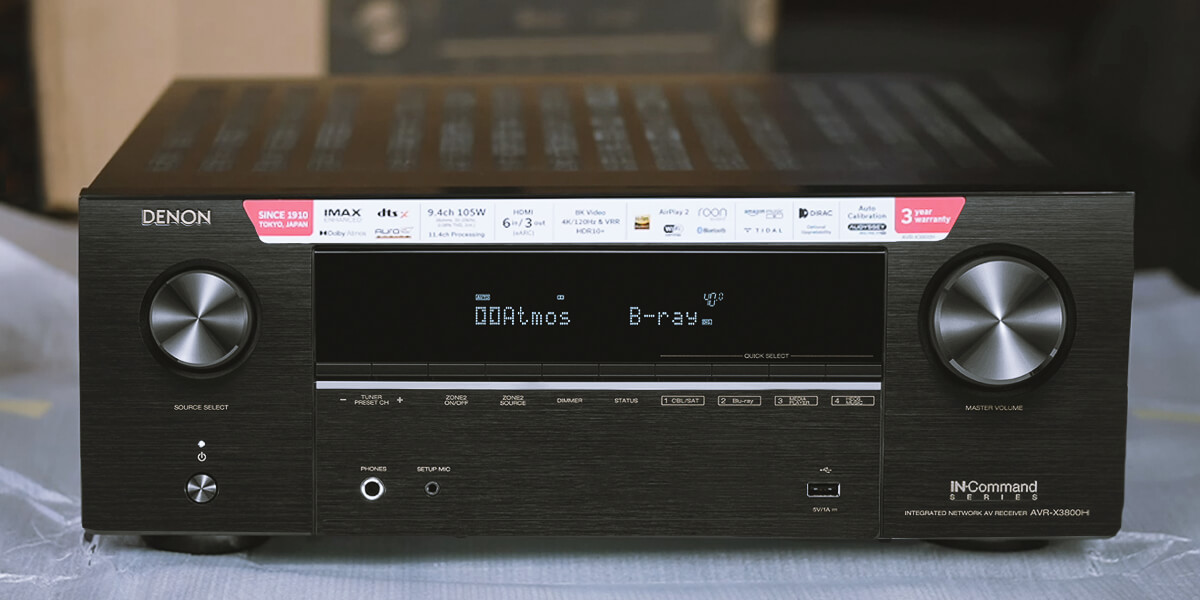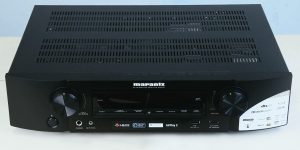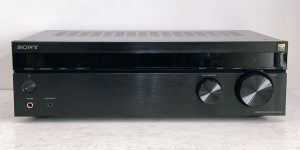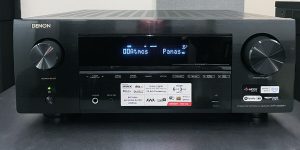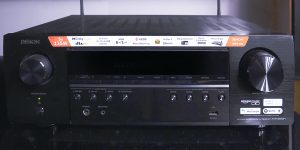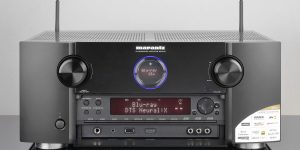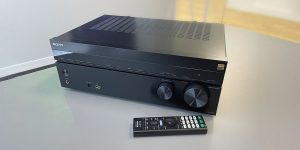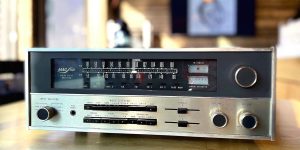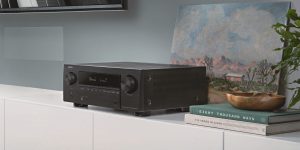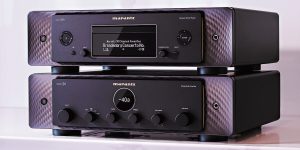Choosing the AV receiver for creating quality Atmos system can encounter difficulties of various kinds. It’s because of the wide variety of models and the wide price range available on the market. Therefore, I offer you my selection of carefully chosen models, among which you will surely find your best 9.2 receiver.
I think a 9-channel configuration is an optimal choice for those who have some money and want to improve their home theater experience. But first, I’d like to look at the general outline of what such a device can offer us.
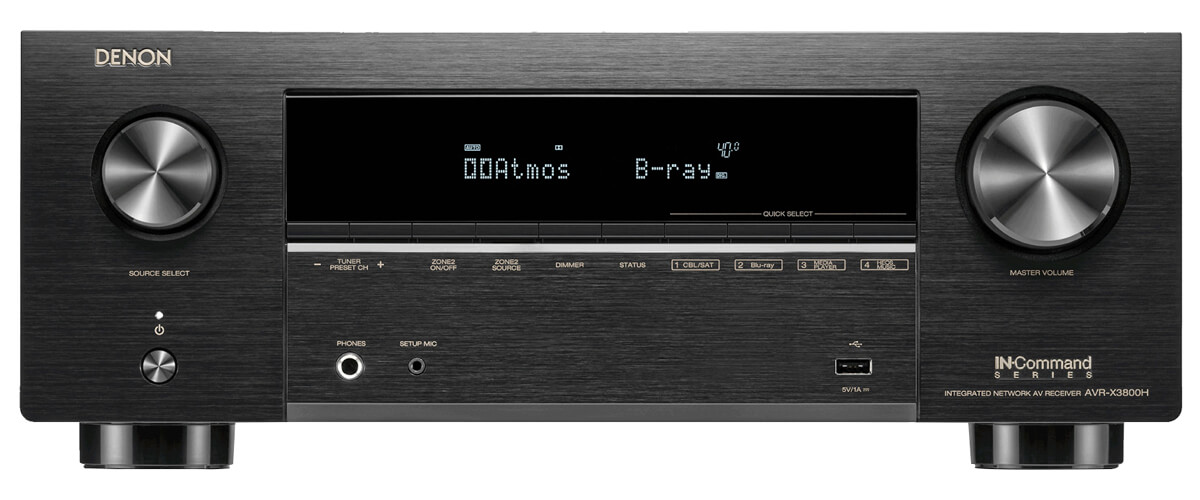
9.2 receivers comparison table
| Name | Channels | Power output | HDMI in/out | Bluetooth/Wi-Fi | Review |
|---|---|---|---|---|---|
| Denon AVR-X3800H best overall | 9.4 | 105W/8 Ohm, 135W/6 Ohm | 6/3 | yes/yes | Review |
| Marantz Cinema 50 also great | 9.2 | 50W/8 Ohm, 70W/6 Ohm | 6/1 | yes/yes | Review |
| Onkyo TX-RZ50 budget | 9.4 | 120W/8 Ohm | 7/2 | yes/yes | Review |
9-channel home theater system explained
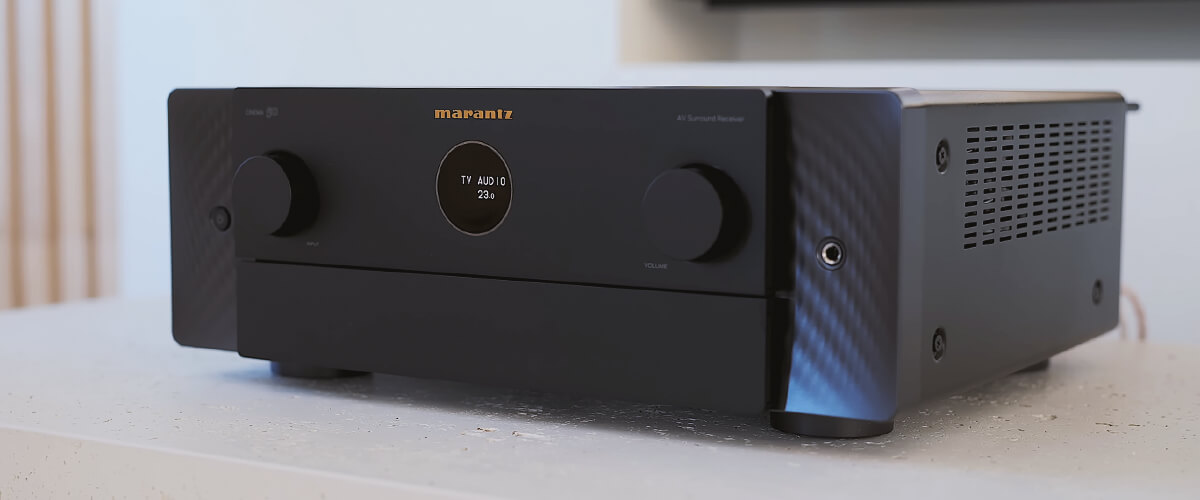
So, the AV receiver with 9 channels is really the optimal system for the latest surround sound formats (Dolby Atmos, DTS:X, and Auro 3D) as it offers configurations with which you can get surround sound close to the real thing and, if not affordable, then acceptable cost. So you’ll get a completely different experience when watching movies or entertainment content (including video games and sports). Still, you won’t be scraping the rest of your savings from all your stash. The pitch channels used in such a system nuance the sound picture more, distributing the audio from speaker to speaker as the picture moves across the screen, ultimately giving you a sense of presence and participation in the events.
Depending on the room size where you place your home theater, you can build a 5.2.4 or 7.2.2 configuration with a 9.1 receiver, where the last number refers to the number of high-rise/ceiling-mounted speakers. But for fans of incredible bass, my list includes receivers with the ability to connect four subwoofers. Wow, isn’t it? Let’s get acquainted sooner.
Best 9.2 receiver reviews
Denon AVR-X3800H – best overall

My top pick for this review is the Denon AVR-X3800H 9.2 channel receiver. The 2022 model from the Denon Soundmaster line has an optimal price/quality ratio and has already managed to break into the popular trends. In fact, the receiver can expand to 11 channels, although it loses out externally to its competitors, being rather unassuming compared to the rest.
A quick glance at the technical specifications of the receiver shows that it is undoubtedly a modern device that meets all the parameters on which I choose receivers. First, the AVR-X3800H is quite powerful in 105W (8 Ohm, 20Hz – 20kHz, 0.08%, 2ch). And that means maximum experience when watching content in the DTS:X (including Virtual:X, Neural:X) and Dolby Atmos surround sound formats that it supports. And as a bonus, you get IMAX Enhanced, 360 Reality Audio, and Auro 3D. Not that it sets it apart from my list, but since it’s the first on it, it was worth noting such factors, especially considering its affordable price against, for example, the Marantz Cinema 50 and Yamaha RX-A6A of the same category. But the AVR-X3800H has only two audio transmission zones.
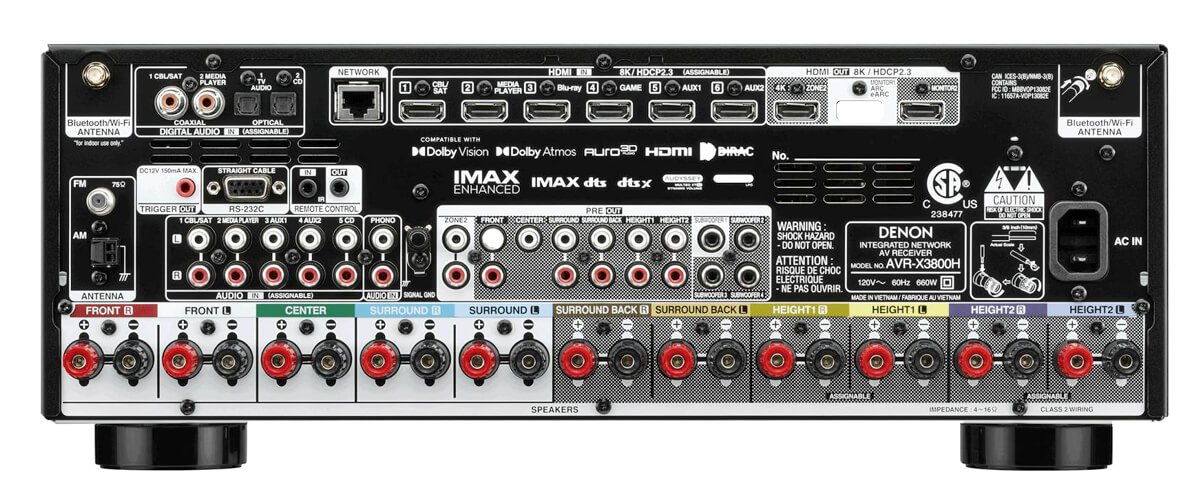
Six HDMI 2.1 inputs support 8K UHD resolution (8K/60Hz and 4K/120Hz) as well as Dolby Vision and HDR10+. What I appreciate most is the 8K scaling and 3D Signal Pass-through.
The connectivity options are pretty extensive and include old and new inputs for connecting various appliances and wireless Wi-Fi and Bluetooth connectivity. Since I’m a music connoisseur, the phono input and built-in HEOS are important to me. And you might like Siri, Alexa, Google Assistant, and support for streaming services, including Roon Tested for true audiophiles.
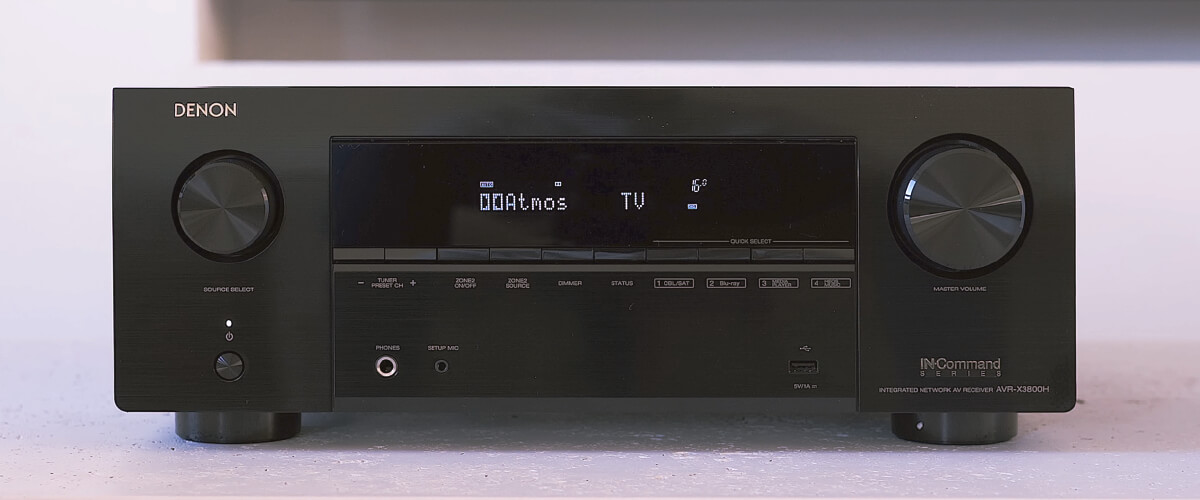
I never hide my special relationship with Denon and appreciate its warm sound. In the AVR-X3800H, the brand has switched to advanced Dirac Live. Well, that’s cool, but it can be tricky compared to its regular Audyssey MultiEQ XT32. But let me move on to describing the experience of watching Greenland. Remember the scene with the birds? It felt like they were flying right above me. I was squeezed into the couch during the approaching sound wave from the falling asteroid. All in all, everything is great: powerful, clear, detailed dialog and great midrange during tense moments.
The Denon AVR-X3800H is the best 9-channel receiver on my list. It offers good connectivity and supports all the most common modern surround sound and video formats, all for quite reasonable money. During testing, I have not found any serious problems and, therefore, objectively give it such a high rating.
Key specs
- Channels: 9.4.
- Power output: 105W/8 Ohm, 135W/6 Ohm.
- HDMI inputs/outputs: 6/3.
- Video functions: 8K/60Hz, 4K/120Hz pass-through, upscaling to 8K.
- Bluetooth/Wi-Fi: yes/yes.
- Streaming services: AirPlay 2, Spotify, TuneIn, Deezer, Tidal, Netflix, Amazon Prime.
- Supports: HDMI ARC, HDMI eARC, HDMI CEC, HDCP2.3, HDR10+, Dolby Vision, 3D Signal Pass-through.
- Surround sound: DTS HD Master, DTS:X, DTS Neural:X, DTS Virtual:X, Dolby TrueHD, Dolby Atmos, Dolby Atmos Height Virtualization, IMAX Enhanced, Auro 3D.
Pros
- Expandable up to 11.4 channels.
- Support for the latest surround sound formats, including Auro 3D.
- 8K support and scaling.
- Advanced Dirac Live autocalibration.
- Clear, reasonably powerful, and warm sound.
Cons
- Unimpressive appearance compared to other receivers in this category.
- Dirac Live may seem complicated.
Marantz Cinema 50 – also great
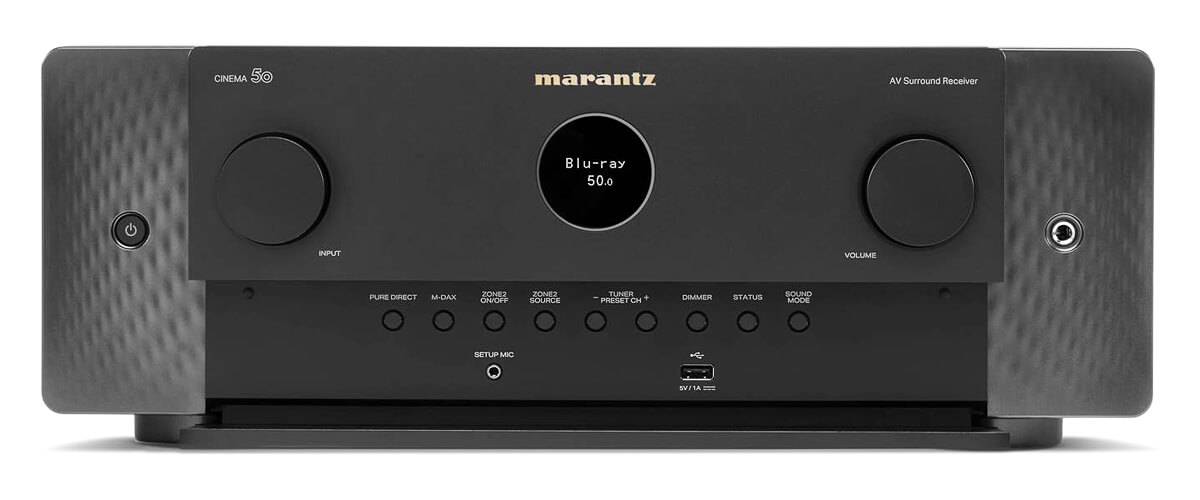
Another great mid-range 9.4 channel receiver is the Marantz Cinema 50, released in 2022. Honestly, this receiver is almost identical to the Denon AVR-X3800H. However, it certainly looks more presentable (although I’m not too fond of the small round LCD) and a bit more powerful (it offers 110W (8 ohms, 20 Hz – 20 kHz, 0.08% 2ch). It does cost a bit more, though. And if I’ve strayed into comparisons, the Yamaha RX-A6A, which is in the same price category, can only connect 2 subwoofers. So, as you can see, there are always advantages.
It is worth noting the incredible build quality of the Marantz. It is exactly what its fans appreciate it for. Well, and the unique sound, which I will talk about a little later. So is it worth the money if you want branded quality for years? That’s up to you to decide.
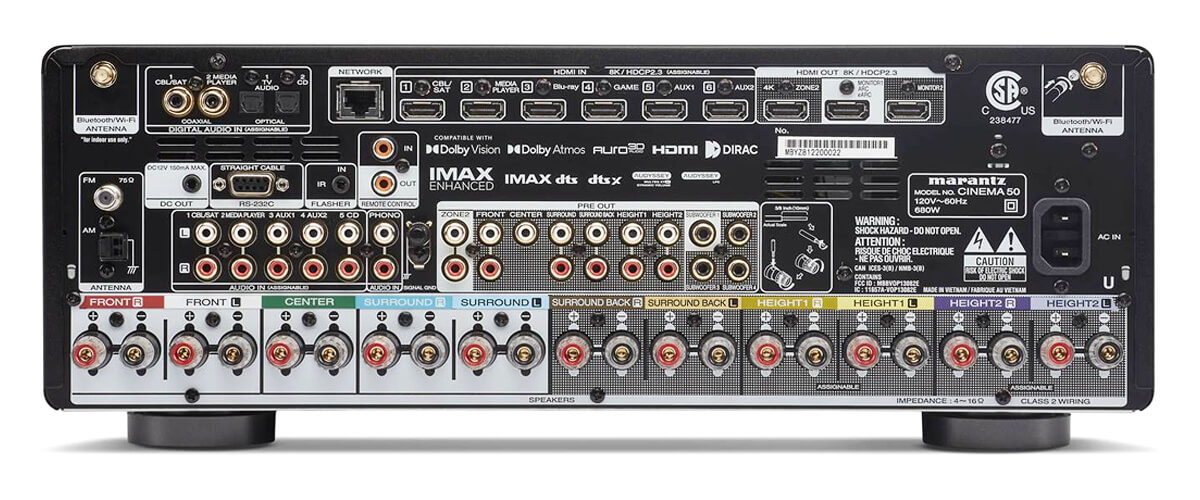
So, here we also have 4 independent subwoofers and the ability to expand the system up to 11 channels. Cinema 50, as well as the AVR-X3800H, works with DTS:X, Dolby Atmos, IMAX Enhanced, Auro-3D, and 360 Reality Audio. There are no differences in the video aspect either, with the receiver supporting Dolby Vision and HDR10+ at 8K/60Hz, 4K/120Hz, and upscaling to 8K. The models also have an equal number of HDMI ports (6/3) supporting HDCP 2.3, ARC, and eARC. Everything is the same as Denon’s.
The Marantz Cinema 50 differs from the AVR-X3800H in the number of connectivity options. For example, it has no component or composite inputs. Is that a disadvantage? For me, most likely, yes. And although I respect modern trends, I do not think giving up old-quality equipment is necessary. But at least there are digital optical inputs and a phono input. Thank goodness.
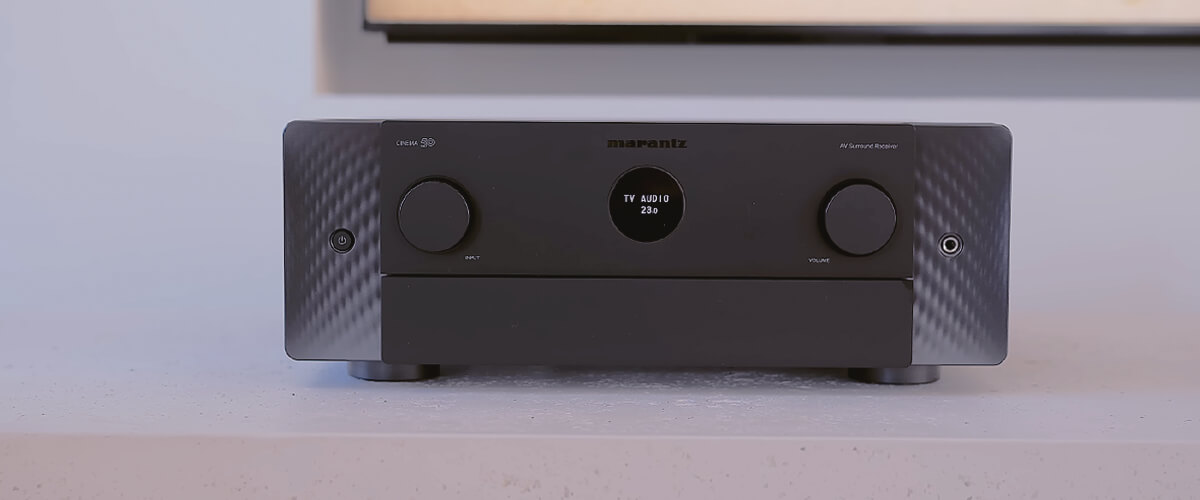
The wireless connectivity is also almost indistinguishable from the Denon. It works with voice assistants, including Apple HomePod (which Denon doesn’t have) and streaming services. Sound is also streamed to 2 zones, and there’s a built-in HEOS system, which by the way, is native to Denon. And even the Audyssey MultEQ calibration system with the Dirac Live upgrade is almost identical.
I watched Avatar with it, and of course, all my skepticism faded away like it never happened. It’s just a stunning soundtrack. Especially when the helicopters flew, I wanted to cover my head with my hand, so real were their flights. Pandora’s incredible nature sparkled with various sounds, and I could hear the movement of every petal, every rustle. I also tried every service and voice assistant available and have no complaints. The connection to my iPhone was just fine, without the slightest hint of interruptions or inaccuracies.
The Marantz Cinema 50 is an excellent high-end receiver in its category. One of the best 9.2 receivers overall and the King of 9-channel AVRs on my list for build quality and sound. It will last its owner a long time; there is no doubt about that.
Key specs
- Channels: 9.4.
- Power output: 50W/8 Ohm, 70W/6 Ohm.
- HDMI inputs/outputs: 6/1.
- Video functions: 8K/60Hz, 4K/120Hz pass-through, upscaling to 8K.
- Bluetooth/Wi-Fi: yes/yes.
- Streaming services: AirPlay 2, Spotify, TuneIn, Deezer, Tidal, Netflix, Amazon Prime.
- Supports: HDMI ARC, HDMI eARC, HDMI CEC, HDCP2.3, HDR10+, Dolby Vision.
- Surround sound: DTS HD Master, DTS:X, DTS Neural:X, DTS Virtual:X, Dolby TrueHD, Dolby Atmos, Dolby Atmos Height Virtualization, Dolby Atmos Music, Dolby Surround.
Pros
- Excellent quality build parts.
- You can add 4 subwoofers.
- The great sound quality in any format.
- Compatible with Apple.
Cons
- Uncomfortable small LCD.
- No component inputs.
Onkyo TX-RZ50 – budget
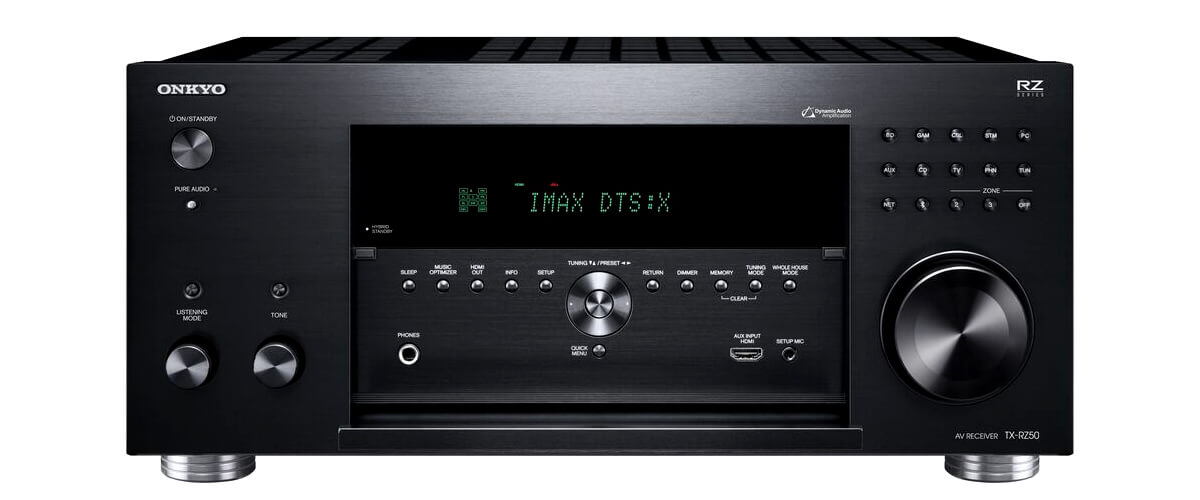
The best budget 9.2 receiver on my list is undoubtedly the Onkyo TX-RZ50 2021. This receiver can also offer system expansion up to 11 channels (it has pre-outlets for 7.2.4 systems), although, unlike Denon and Marantz, you can only connect 2 subwoofers to it. And while the TX-RZ50 is rugged and reliable, I wouldn’t say I like the push-button controls on the front panel, as I foresee all those buttons getting covered in coat and dirt soon. But maybe you’re not a slob like me.
The Onkyo is more powerful than previous models and is rated at 120W (8 Ohms, 20Hz – 20kHz, 0.08% THD, 2 ch). If you live in an apartment, I don’t envy your neighbors. Especially if you, like me, are a fan of heavy rock.
The receiver has only 1 less HDMI output than its predecessors, but the ports support 8K/60Hz (for Zone 1) and 4K/120Hz (for Zones 1 and 2) and Dynamic HDR formats. Other connections include a phono input and jacks for older equipment (unlike the Marantz). But you won’t find the up-scaling function here.
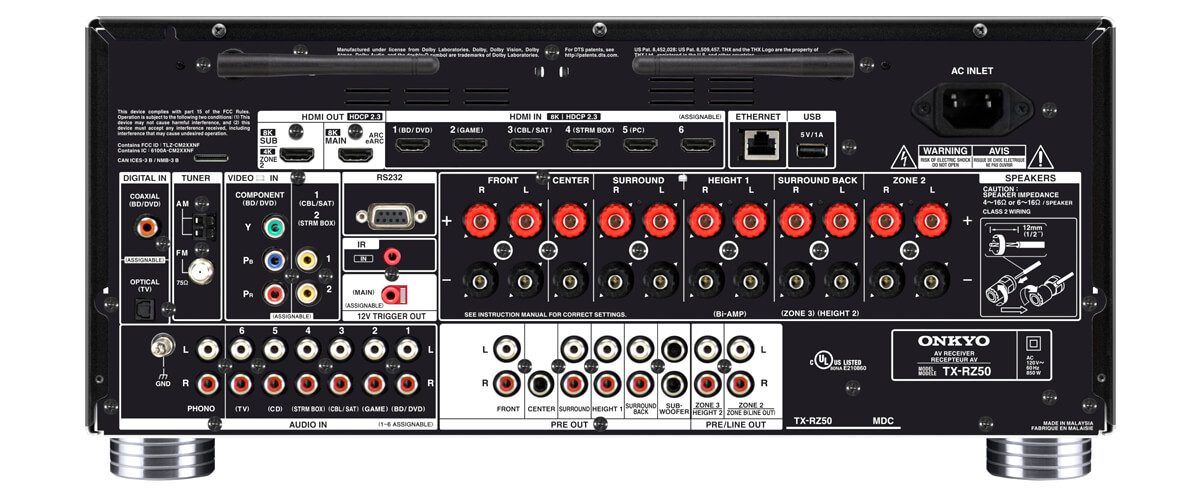
The TX-RZ50 is also smart in surround sound, supporting DTS:X, IMAX Enhanced, and THX Certified Select. But it has a special relationship with Dolby Atmos. AccuReflex’s special phase-matched speaker solution with support for this format will allow you to enjoy the content “just enough,” as the manufacturer says. I assure you, most of you won’t notice the difference. But the receiver broadcasts audio to 3 Zones. All in all, there’s plenty to choose from.
Some features are inherent in the Onkyo TX-RZ50 with wireless streaming as well. For example, it is DTS Play-Fi Ready, which means a wide range of device compatibility and high transmission quality. And improved Bluetooth using SBC, aptX, or aptX HD codecs. Owners of Apple devices will be pleased as this makes the receiver compatible with them, including working with the voice assistant. Some streaming services and MusicCast are also built into the receiver. The model is also compatible with 4 to 16 ohms speakers, making it a versatile device for any system.
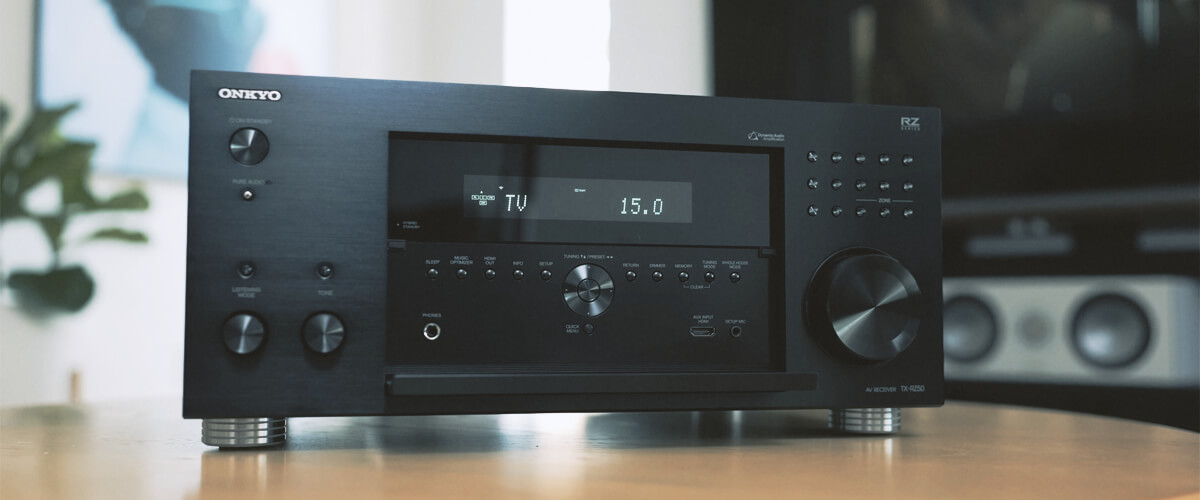
Onkyo also used Dirac Live Room Correction as an auto-calibration, making the process a bit more complicated. But let’s get to the listening experience. The receiver is slightly inferior in quality to more expensive models, but the unsophisticated viewer may not notice it. The sound when watching Autómata was powerful and rich, quite detailed. For example, the car chase scene enveloped me so much that I felt right with the characters. The sound didn’t mix, and the details were audible. There was no problem with the music on the wireless broadcast, and I could hear the Arctic Monkeys equally in all areas of my house. I was very satisfied with it.
The Onkyo TX-RZ50 is a great choice for those who aren’t chasing a brand name but have wanted a decent home system for years. If you are a modern person who prefers modern chips, the functionality of this AVR will be enough for you.
Key specs
- Channels: 9.2.
- Power output: 120W/8 Ohm.
- HDMI inputs/outputs: 7/2.
- Video functions: 8K/60Hz, 4K/120Hz pass-through, upscaling to 8K.
- Bluetooth/Wi-Fi: yes/yes.
- Streaming services: AirPlay 2, Spotify, TuneIn, Deezer, Tidal, Netflix, Amazon Prime.
- Supports: HDMI ARC, HDMI eARC, HDMI CEC, HDCP2.3, HDR10+, Dolby Vision.
- Surround sound: DTS HD Master, DTS:X, DTS Neural:X, Dolby TrueHD, Dolby Atmos, Dolby Atmos Height Virtualization, Dolby Surround, IMAX Enhanced.
Pros
- High Power.
- THX Certified Select availability for a better audio experience.
- DTS Play-Fi Ready and Advanced Bluetooth (SBC, aptX, or aptX HD).
- Ability to stream audio to 3 Zones.
- Compatible with a wide range of speakers from 4 to 16 ohms.
Cons
- The push-button control solution is not optimal.
- No up-scaling.
Yamaha RX-A6A
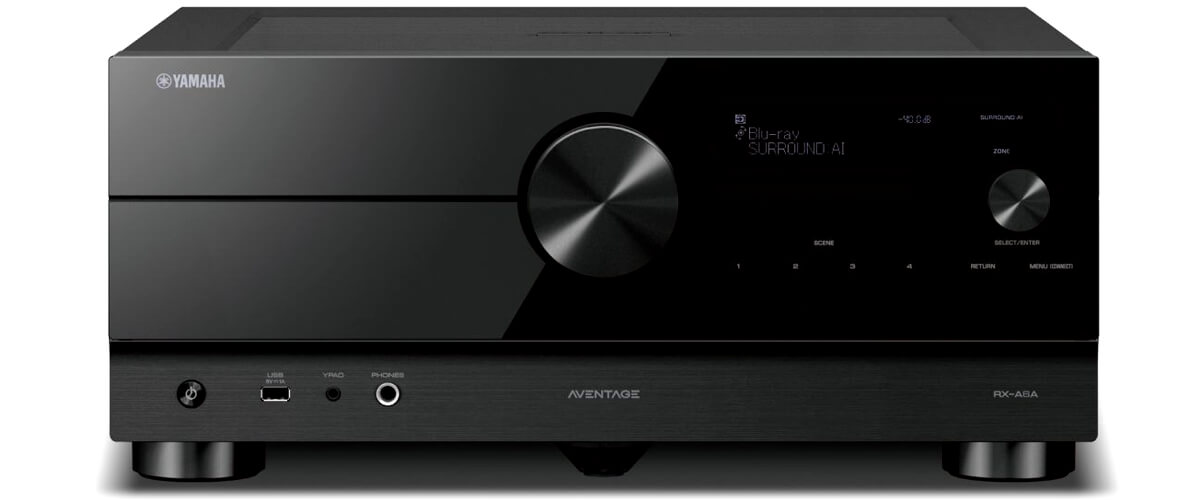
The next 9.2 Dolby Atmos receiver in my list can probably be compared only with Marantz Cinema 50 because they have approximately the same price (by the way, the highest of all presented in this review). But the Yamaha RX-A6A 2021 is worth it because, besides the extra terminals to expand the configuration to 7.2.4 (11 channels), it is simply a monster compared to the Cinema 50 (and even the Onkyo). Therefore, I highly do not recommend it for an apartment (poor neighbors); use it in a house where only you can deafen. So, it has 150 watts per channel (8 ohms, 20Hz – 20kHz, 0.06% THD, 2ch). And the only thing I don’t understand is the completely unviewable LCD in the corner of the front panel, even though the receiver looks awesome.
I want to start by saying that the RX-A6A supports Dolby Atmos, Auro-3D, and DTS:X surround sound formats with CINEMA DSP HD3, giving you concert sound levels. And the Multi-Room function allows you to add 3 additional Zones with an external amplifier. So that is a total of 4 Zones! But, again, this is a technique for the big house.
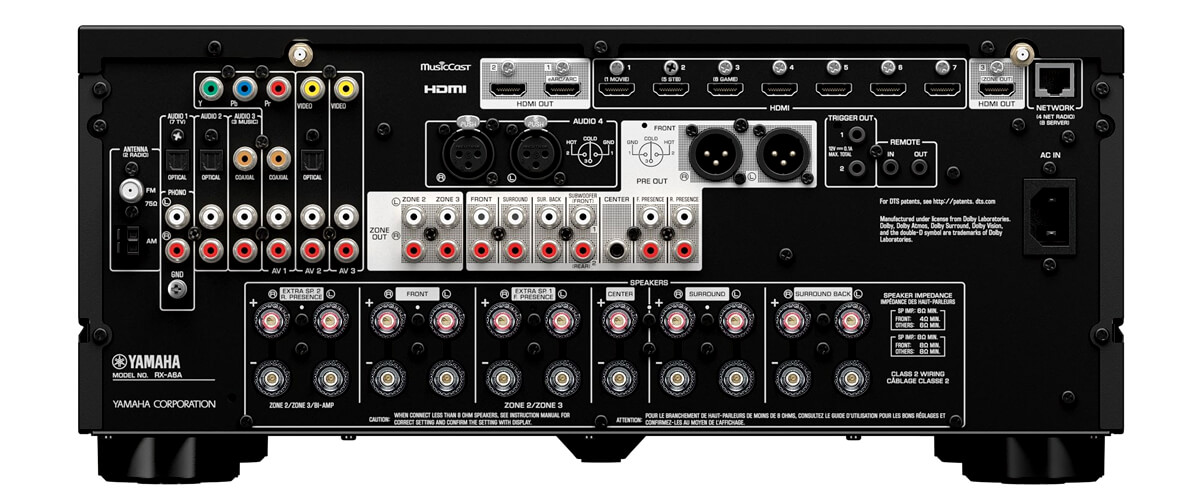
The Yamaha is beyond competition regarding video as it has 4K/120 and 8K/60 HDMI and HDR10+ (HDCP 2.3 and eARC). The 7 inputs and 3 outputs are more than the Marantz Cinema 50, and that’s cool. But, of course, I’d be surprised if there wasn’t an upscaling feature to 8K. The rest is more or less similar: there are several inputs for various old equipment, a phono input, but only 2 subwoofer outputs. So fans of shaking from the bass walls will have to choose.
Wireless connection is standard and allows you to work with voice assistants and streaming services, many of which are integrated (Amazon Music, Spotify, Pandora).
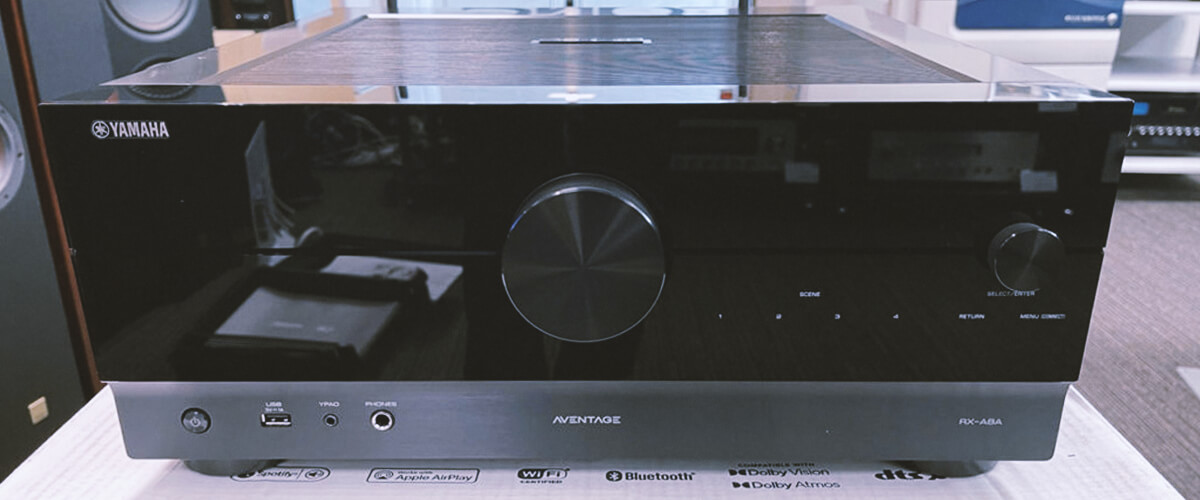
YPAO auto-calibration is standard on Yamaha equipment, and I really like it because it is the easiest for me. That said, it works great in any room. The sound of the Yamaha RX-A6A is as cool and clear as the brand’s other models. And it’s a sound you have to love. For example, I like to listen to heavy rock metal with this technique, where the distortion should sound as ringing as possible. That’s why I played AC/DC, and from my heart, I was repeating Angus Young’s moves to Thunderstruck. I hope you don’t have a wild imagination. It was perfect. I also chose a musical movie, and it was The Dirt. The sound of “Mötley Crüe” in the film is amazing: clean as far as is acceptable in a genre like this; clear, powerful, and nuanced to the smallest detail. Super Dynamic.
Yamaha RX-A6A is a true bison among other models. It is powerful, functional, assembled from high-quality components, and, most importantly, has a clear concert sound.
Key specs
- Channels: 9.2.
- Power output: 150W/8 Ohm.
- HDMI inputs/outputs: 7/3.
- Video functions: 8K/60Hz, 4K/120Hz pass-through, upscaling to 8K.
- Bluetooth/Wi-Fi: yes/yes.
- Streaming services: AirPlay 2, Spotify, TuneIn, Deezer, Tidal, Netflix, Amazon Prime.
- Supports: HDMI ARC, HDMI eARC, HDMI CEC, HDCP2.3, HDR10+, Dolby Vision.
- Surround sound: DTS HD Master, DTS:X, Dolby TrueHD, Dolby Atmos, Dolby Digital Plus, Dolby Atmos Height Virtualization, Dolby Surround, Auro-3D.
Pros
- Very high power compared to other models – 150W.
- 4 Audio Broadcast Zones.
- DTS:X with CINEMA DSP HD3 offers a sound concert level.
Cons
- Very small and uncomfortable LCD.
Pioneer Elite VSX-LX305
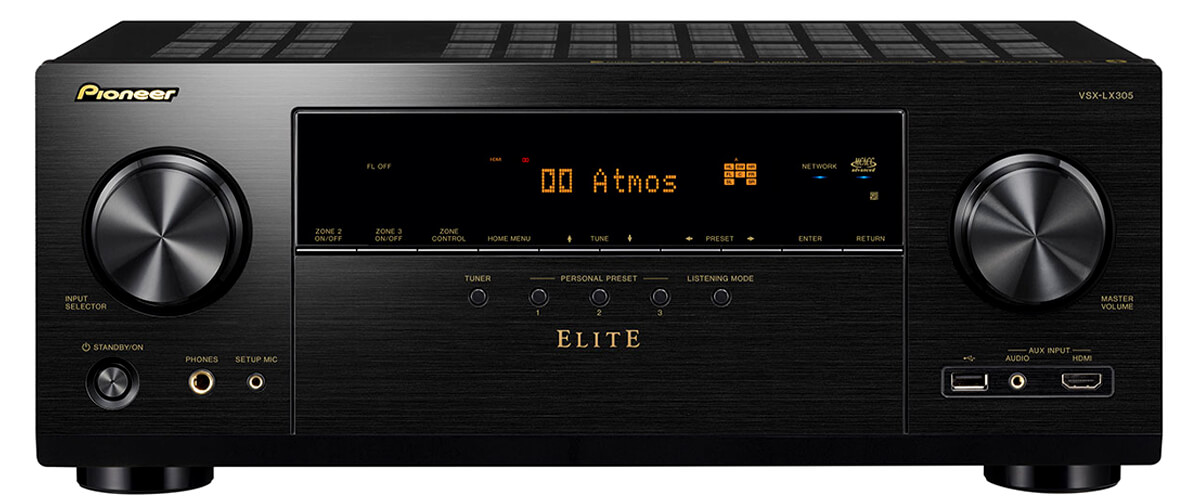
The cheapest 9-channel AVR on my list, and the last on it, is the Pioneer Elite VSX-LX305. Today it is the brand’s flagship model, and this device, as well as others in this review, can be expanded up to 11 channels. But it is the closest, perhaps, to the Onkyo TX-RZ50. And in terms of design, the Pioneer looks better to me, as its buttons are flat and the LCD, which is centrally located, is easy to see. Also, the VSX-LX305 has a USB port on the front panel, which Onkyo doesn’t have.
The Pioneer Elite VSX-LX305 is weaker than the Onkyo in terms of power and offers 100 watts (8 ohms, 20Hz-20kHz, THD 0.08%, 2ch), and at too high a volume, you can hear a crackling and unwanted hum, so I didn’t crank the maximum. Although, frankly, this applies to almost all receivers because only two-channel amplifiers give a really clear sound. But only Pioneer Elite has the bi-amping function.
In terms of video options, the receivers are similar. The same number of HDMI ports gives you 8K/60Hz and 4K/120Hz Passthrough and Upscaling 1080p to 4K/8K and 4K to 8K. The HDR10 and HLG formats supported by the VSX-LX305 are the same as the Onkyo, but Dolby Vision is not with both.
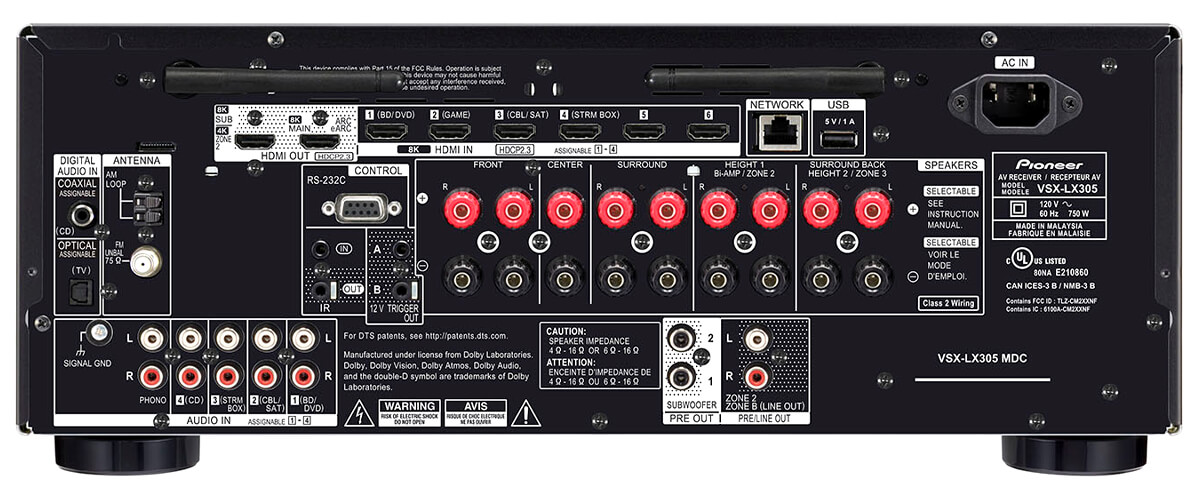
Dolby Atmos and IMAX Enhanced surround sound formats are available with this model, and if it matters to you, no DTS:X, although there are earlier versions of it. All in all, it’s a little easier again, but that’s understandable. After all, the price is much lower. So in the case of the Pioneer Elite VSX-LX305, I would rather say, “Wow! This little guy almost reaches the giants!”. Great options.
It also has Sonos connectivity, DTS Play-Fi streaming, Bluetooth streaming and working with streaming services and voice assistants, and streaming audio to 3 Zones. I didn’t really like the Bluetooth performance, though: I had to get a little further than 5 meters away, and the signal would stutter. It’s not critical, but I’m trying to be objective. This model also has Dirac Live Room Correction auto-calibration, the complexity of which I have already mentioned.
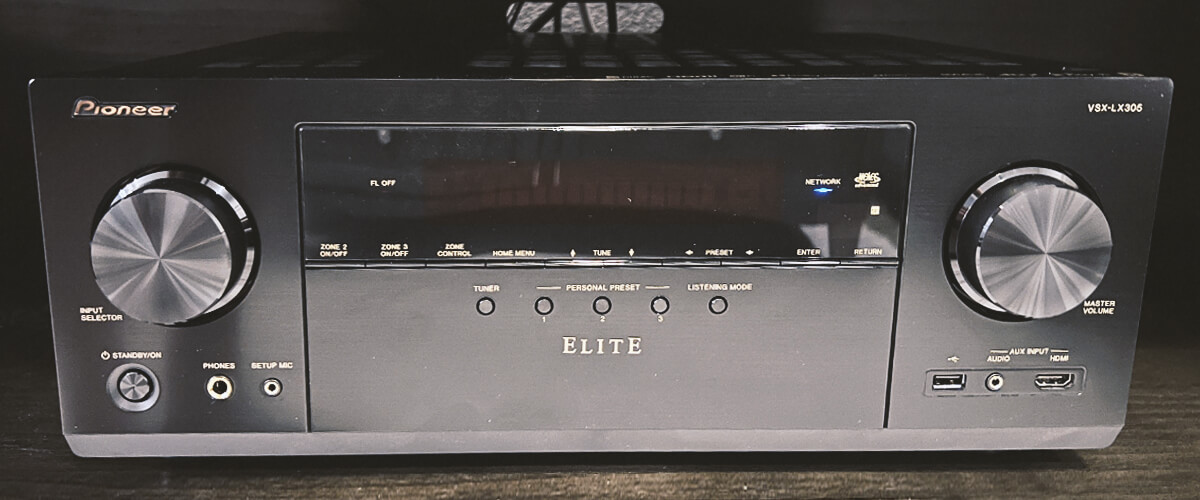
I watched Kung Fu Panda with great pleasure with the VSX-LX305. Both picture and sound worked clearly, without delay or interference. The dialogues were clear and crisp, even when Master Oogway was involved. The petals falling from the peach tree seemed to fly by my ear. The music was warm and gentle with Ace of Base, and I enjoyed the soft vocals and my childhood sounds while trying out Sonos. I thought it was a good receiver that many people could afford, and I put it on my list.
Yes, it’s simple and has fewer advanced features than the other receivers in my review. But the Pioneer Elite VSX-LX305 is here deservedly because, for its affordable price, it can offer options close to the elite models. It is a quality receiver with good sound; many of you will love it.
Key specs
- Channels: 9.2.
- Power output: 100W/8 Ohm.
- HDMI inputs/outputs: 6/3.
- Video functions: 8K/60Hz, 4K/120Hz pass-through, upscaling to 8K.
- Bluetooth/Wi-Fi: yes/yes.
- Streaming services: AirPlay 2, Spotify, TuneIn, Deezer, Tidal, Netflix, Amazon Prime.
- Supports: HDMI ARC, HDMI eARC, HDMI CEC, HDCP2.3, HDR10+, Dolby Vision.
- Surround sound: DTS HD Master, DTS:X, Dolby TrueHD, Dolby Atmos, Dolby Digital Plus, Dolby Atmos Height Virtualization, Dolby Surround, IMAX Enhanced.
Pros
- The design is practical, and the LCD is handy.
- There is a bi-amping function.
- Supports Dolby Atmos audio formats and IMAX Enhanced, but not DTS:X.
- Compatible with Sonos.
Cons
- Does not support Dolby Vision.
- Bluetooth performance was not stable over long distances.
- Difficult to adjust Dirac Live Room Correction calibration.
9.2 AV receiver buying guide
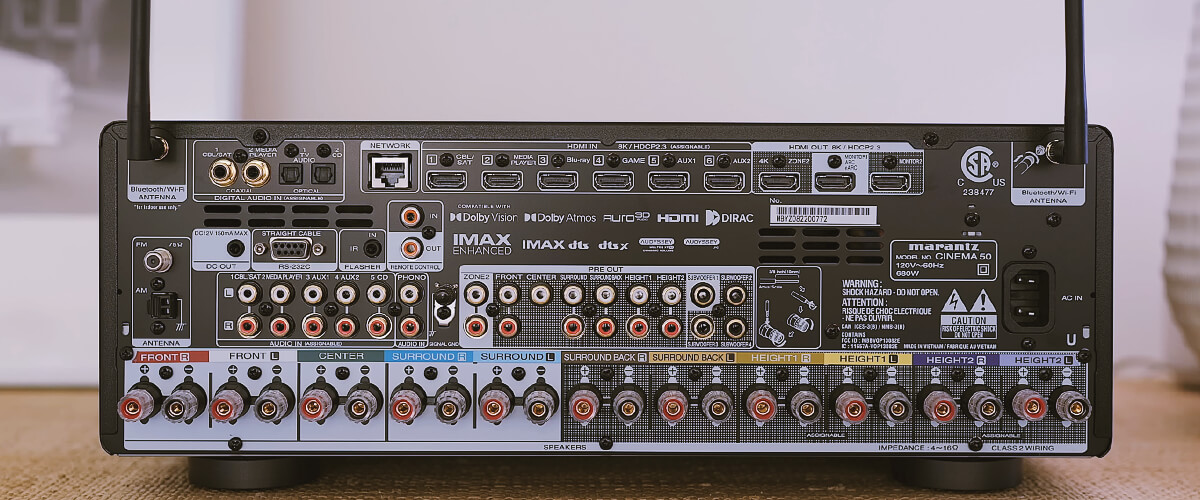
Amplifier power rating
Power is not a determining point when choosing a receiver, but since we are talking about a 9-channel system, you need to understand that we are talking about placing it in a considerable room. It would be better to hear what is happening on the screen fully. That’s why such systems usually offer more than 100 watts per channel, which provides enough power for most rooms. But I would rather pay attention to the THD value because I prefer pure to loud sound. And it is important to realize that your speakers are just as important regarding volume and clarity.
Connectivity options
In today’s interconnected world, having multiple connection options is crucial when choosing an AV receiver 9.2. Most important to us are the HDMI inputs and outputs and the eARC and HDCP formats they support. It greatly improves the transmission and quality of the signals. Some of you who use aging traditional equipment may care about component connectors, and vinyl enthusiasts absolutely need a phono input.
Built-in Bluetooth and Wi-Fi capabilities provide seamless streaming and easy integration with other devices in your home, for example, wireless ecosystems, voice assistants, and streaming services.
Video features
Since we are looking at models released in the middle price range in recent years, they all have 8K/60Hz video resolution support and allow you to watch HDR10, Dolby Vision, and HLG quality content. But only if your TV also supports these formats. Such a receiver will last you a long time because all these are the latest innovations in video. I pay attention to the presence of the scaling function because if you watch old movies from old media, the quality on the screen with this technology will be better than the original.
Surround sound formats
Modern surround sound formats play an important role in creating immersive audio. So when choosing a 9.2 receiver, prefer devices that support Dolby Atmos, DTS:X, and Auro-3D. Although, frankly speaking, almost all of them support that level of surround sound and sometimes offer advanced concert sound technology. Not all content today is released with such soundtracks, but time is of the essence, and we want to buy equipment that will last us a long time.

